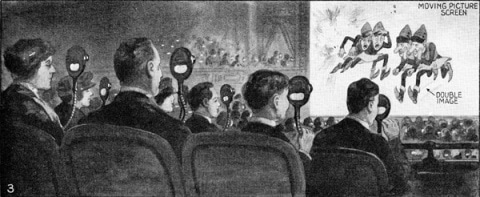Lifestop wrote:This is probably a dumb question, but could strobing (sort of) be accomplished through the use of active shutter glasses (3d television) synced up with a pc display? Instead of blocking vision in one eye at a time for 3d, why not block both eyes for brief intervals to accomplish something similar to ulmb?
I'm not tech savy, but just a little curious after reading about how active shutter glasses work.
I'm answering in a "What if?" scientific matter of interest, rather than practicality.
Usually, when this question is asked, the original poster has a scientific curiousity, so here goes:
Short Answer: Yes
See
old thread
Long Answer: It's yes, but with some tricky gotchas
1. You still need a fast display where the GtG is mostly complete in VBI between refresh cycles, see high speed videos
http://www.blurbusters.com/scanout
2. You need fast GtG in the shutter. LCD shutter glasses take time to open and close.
3. Synchronization with display refreshes. That can be challenging.
It also even works with mechanical wheels with holes in them. Running
http://www.testufo.com/photo on a standard LCD, putting a desk fan in front of monitor -- shows some erratic motion blur reduction behaviours too (unsynchronized strobing). And old 1920s 3D movie experiments used mechanically-strobed 3D glasses:
Film projector strobing shutters (can be homebuilt/jerryrigged with home projector to reduce blur)

Mechanically strobed 3D glasses, circa 1920s experiment

...........
An Ardino + motor can spin a wheel in front of an LCD/LCoS projector and successfully do ULMB with a projector. Don't do it with DLP because of its temporally-generated color, but it would work with LCD/LCoS projector technology. Two 5% slice removed from opposite edges of a wheel (need to keep it weight-balanced), spun 30 times a second for 60Hz (60 strobes) or spun 60 times a second for 120Hz (120 strobes), attached to a motor that is spun by an Arduino in sync to a VSYNC... and you get 90% motion blur reduction on an LCD/LCoS projector! (Though, with a 90% light loss).
If no VSYNC feed, have accurate analog knob for speed in 0.001 Hz increments, so you can do manual genlock the strobe by slewing the rolling artifacts until they were between refresh cycles (visual strobe-in-VSYNC calibration exactly much like how I use Blur Busters Strobe Utility on an XL2720Z). Might be able keep manual drift-readjustments to once every few minutes if your adjustments are fine enough and you eyeball a good motion-test-pattern. You could also use a USB-bus VSYNC feed (from a system tray app monitoring .InVBlank and transmitting those to the Arduino) and use some "noisy-VSYNC" filtering logic (similiar to the one ad8e provided for his C++ equivalent of Tearline Jedi) to filter the USB ping jitter to get the original VSYNC tick-tock. Stick to Arduinos with <1ms USB lag though.
Arduino-driven spinning-mechanical-wheel strobing works excellently with lowering persistence of sample-and-hold LCD/LCoS projectors. I've talked about this years ago too.
If anyone does a spinning-disc persistence-lowering device for LCD/LCoS device, please post here. It's a fun cheap Arduino experiment.
Tips for external strobing devices (glasses, mechanical):
- Manual genlock mode (need to be able to speedup/slowdown in tiny increments with an analog knob)
- VSYNC trigger genlock mode (listen to an external VSYNC signal on a GPIO pin)
- Phase offset adjustment (flash position relative to VSYNC position)
- Length variable (slit size on spinning wheel, or shutter length for active shutters)
- For rolling shutters, roll the shutter downwards, in sync with rolling scan, for best results. Most LCD/LCoS microdisplays use a downward sweep,
www.blurbusters.com/scanout
